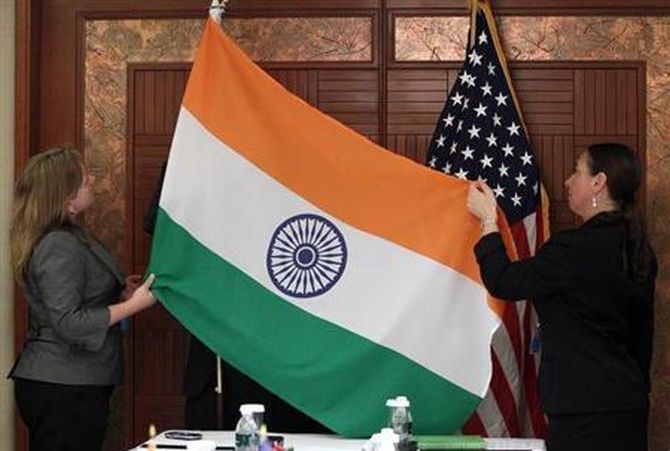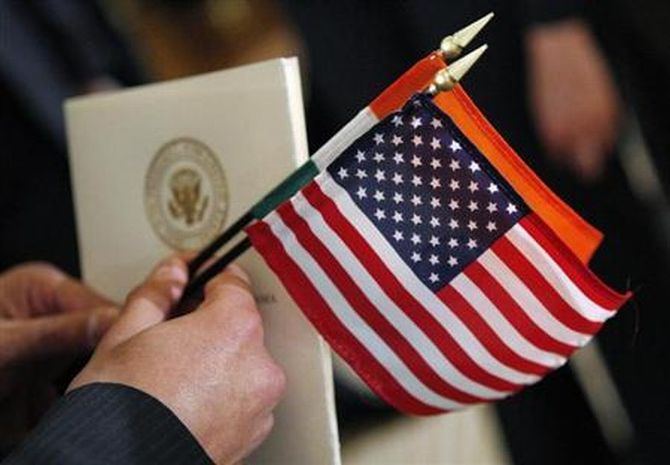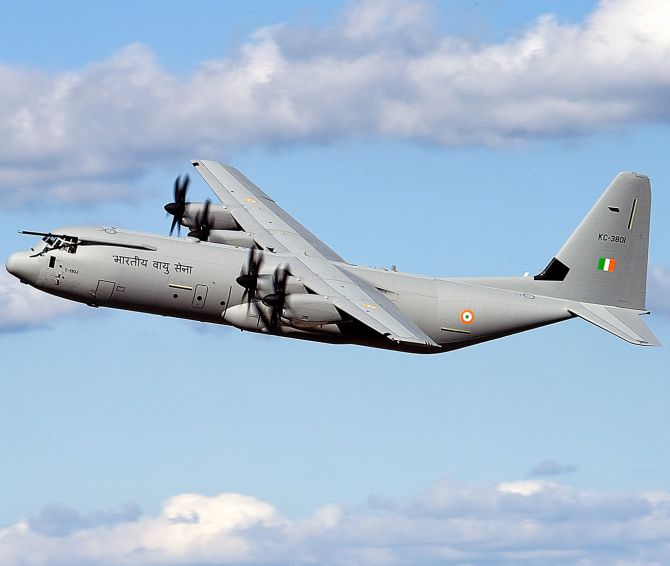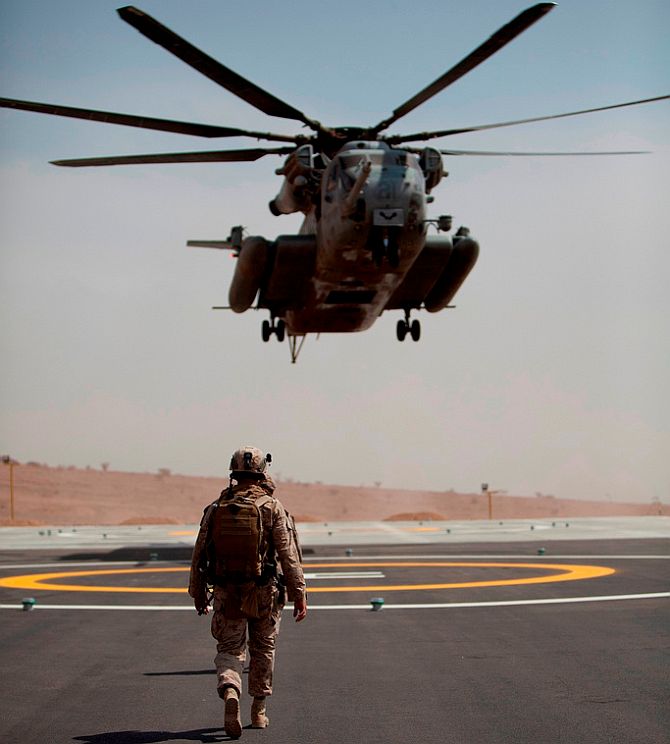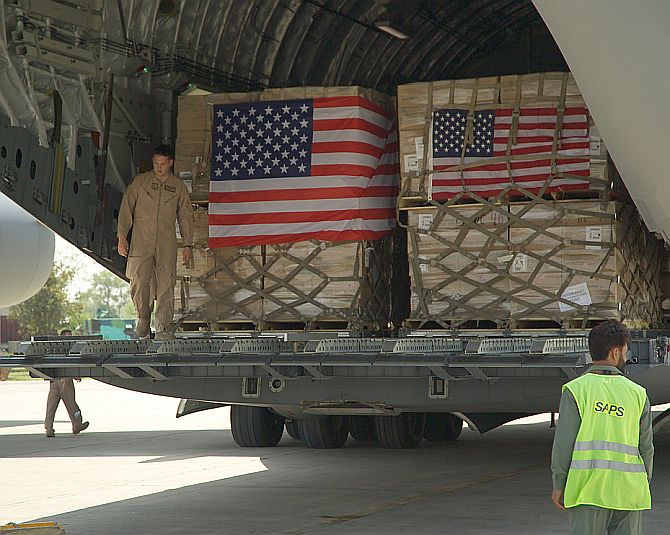 | « Back to article | Print this article |
The India-US love story is soaring
The medium and longer term prospects remain very positive for the India-US relationship, feels Kanwal Sibal.
The most important foreign policy development in the last decade has been the remarkable improvement in India’s relations with the United States.
From mutual suspicion, lack of empathy and a policy of keeping the relationship at a low level to avoid giving the US too much leverage over India, we have moved to a relationship of mutual confidence, genuine engagement and belief that the two sides can develop convergent strategic interests.
The rhetoric accompanying this rapprochement is a little overblown on the US side, with President Obama describing the India-US relationship as a defining one for the 21st century.
What this might mean other than a strengthened relationship and greater convergence in the coming years is unclear.
The vision of India becoming such a major pole in global affairs that the India-US tandem will determine the configuration of international relations, the principles governing them, the management of global commons and the consolidation of political and human values acceptable universally seems a little grandiloquent.
India, on the other hand, uses more subdued vocabulary to describe the improving ties, emphasizing their transformed nature, which is a more realistic description of where they stand today.
The Indian government, conscious that it is already being perceived as being too pro-US and aligning itself unduly with US interests, presumably feels the need to keep its rhetoric low-key so as not to invite criticism domestically and raise doubts externally about the independence of its foreign policy decision making.
Nevertheless, the fact remains that for India, its relationship with the US has become the most important one.
Click on NEXT to read further...
The India-US love story is soaring
The range of engagement with the US, reflected in several dialogues in diverse areas that the two countries are holding -- whether it is in the field of energy, education, agriculture, health, development, science and technology, environment, trade, defense, counter-terrorism, non-proliferation, high technology and the like -- far exceeds that with any other country.
The objective is to build Indian capacities in a number of sectors with US technology and know-how, a process that would help India to develop and grow even as the US gets greater access to the expanding Indian economy.
India and the US have had to overcome a difficult legacy. It can be argued that, over decades, the US has done much damage to India’s strategic interests by hamstringing its efforts to develop nuclear and missile technologies, imposing sanctions on India in these areas, denying India high and dual use technologies, overlooking Pakistan’s acquisition of nuclear and missile technologies from China, politically subverting Indian sovereignty over Jammu and Kashmir by interventions on Pakistan’s behalf, arming Pakistan against India, and unleashing Islamic extremism in the region by its decision to use jihadi groups to fight the Soviet Union in Afghanistan.
Progress has been made, even though unevenly, in overcoming this unfortunate legacy.
The change in mutual perceptions began with the Vajpayee government, with the then Indian leadership speaking of India and the US as ‘natural allies’ and taking the initiative to engage the US on divisive strategic issues, especially nuclear and high technology ones.
The slow progress being made was put into really high gear by President Bush, leading to the 2005 India-US civilian nuclear deal and the Nuclear Suppliers Group exception for India, for which the US undoubtedly did the ‘heavy-lifting.’
This deal, however controversial it became in India because of some crucial concessions extracted from India and the misleading hype about its energy potential created by its supporters, the fact is that non-proliferation issues blighting India’s bilateral relationship with the US and pitted India against the majority of the international community for decades have been removed from the agenda, which constitutes a solid political and diplomatic gain.
Click on NEXT to read further...
The India-US love story is soaring
Flowing from this, India has been able to sign civilian cooperation agreements with several other countries, including Canada, with progress in negotiations with Australia and hopeful prospects of an agreement with Japan. India has been able to secure raw uranium for its reactors, overcoming an immediate problem that the Indian nuclear sector faced.
As a result of the US-India nuclear deal, sanctions on almost all Indian entities have been lifted and high technology export controls for India have been eased to a degree.
The US has committed itself to promoting India’s membership of the four technology denial regimes, namely, the NSG, the Missile Technology Control Regime, the Wassenaar Agreement and the Australia Group, which when it happens will integrate India into the global non-proliferation regimes as a non-NPT member.
India’s task will be to prod the US to implement this commitment at the earliest and not use it as a bargaining point to extract more concessions from India in non-proliferation related areas.
The US position on India’s permanent membership of the United Nations Security Council has evolved positively and has contributed to the sentiment in India that the US is now ready to open the strategic space that India claims for itself.
Actual membership will be a prolonged process and will not depend on US alone, thought the US position on expansion will remain crucial.
The US attaches importance to the bilateral dialogue on global commons -- air, space, sea and cyber. It is emphasizing the partnership with India in defining the rules. The intention is to ensure that as India rises and seeks a change in the international rules so far defined by the West, it does so closely with the US so that any disruptive initiatives get forestalled.
In addition, the US seeks burden-sharing in upholding the international system from which it feels others benefit without assuming responsibility. The dialogue on the global commons is intended to steer India towards burden-sharing.
In the maritime domain, freedom of navigation and securing the sea lanes of communication are areas where the US would have particular interest in partnering India, given India’s dominating position in the Indian Ocean and the steady expansion of its navy.
In the new area of cyberspace, cyber security has become a matter of urgent international attention and India’s emergence as a major IT power, along with the vast expansion of its telecommunications network, makes India a partner of choice to establish new rules of the game.
The dramatic change in India’s defence ties with the US in the last decade signifies a notable reduction of the trust deficit between the two countries, given the history of US sanctions and its practice of imposing arms embargoes in situations of tension and conflict.
Click on NEXT to read further...
The India-US love story is soaring
In the last five years or so, the US has bagged orders worth about $9 billion, whether for C-130 and C-17 heavy lift aircraft, advanced maritime reconnaissance aircraft, attack helicopters and VIP helicopters etc.
The US lost out in the competition for the 126 combat aircraft contract, a setback that it did not easily absorb, as it expects a greater share of Indian defense procurements as a testimony of India’s seriousness in treating it as a long term strategic partner.
India has baulked at signing the inter-operability agreement, the logistics agreement and the agreement to have access to high defense technology.
India remains reticent about tying up too much with the US in the defense domain lest it is perceived as having moved too much into the US defense orbit and compromising the independence of its policies. The US is, wisely, no longer insisting on signing them, leaving India to decide as opportune.
What balances this reticence are the numerous joint military exercises with the US involving the three arms. The naval exercises in the Indian Ocean area have been particularly elaborate, involving even aircraft carriers, submarines etc on both sides, which sends an important strategic message because these waters are crucial for the trade and energy flows for China and other East Asian countries.
The US, India and Japan also held the first trilateral naval exercise off the coast of Japan in 2012, though India is inexplicably reticent about such trilateral exercises in the Indian Ocean.
The US move to establish a strategic partnership with India, symbolized by the nuclear deal, has the rise of China an underlying motivation, though this is not acknowledged officially. Chinese commentators interpret this relationship as a move against China, though they find India’s attachment to independent decision making as a reassuring element.
The US has described India as a lynchpin of its pivot or rebalancing towards Asia. While caution is exercised in not making it appear that this initiative is directed at China, the reality is that the rise of China and its growing muscle-flexing, as is evident in its conduct in the South China Sea, requires the US to signal its intention to maintain and reinforce its presence in Asia to give confidence to its allies who may otherwise seek accommodation with China at the expense of the US.
Click on NEXT to read further...
The India-US love story is soaring
In this the US clearly sees India as a vital partner given India’s several attributes that makes it a credible power to rival China in the years ahead. India, however, is wary of this re-balancing strategy as it doubts the capacity and inclination of the US to contain China beyond a certain point because of the huge economic and financial interdependence between the two countries.
India would like to avoid becoming collateral damage in an unclear US strategy towards China.
On the issues of terrorism and religious extremism, while bilateral cooperation in the area of counter-terrorism has progressed, US policies have an element of ambivalence that undermines Indian interests.
The principal US focus is on Al Qaeda and its affiliates, but not on the Taliban whom the US seems ready to accommodate so long as it commits itself to cutting off its links with Al Qaeda and not permit terrorism from areas under its control directed at the West.
For this reason India and the US have difficulty in remaining on the same page on the Afghanistan issue, as well as on some aspects of US policies towards Pakistan, whether it is the reluctance to apply the kind of pressure that Pakistan merits in view of its profound terrorist affiliations to force it to break these links, or contain the ambitions of the Pakistani military in Afghanistan. US arms aid to Pakistan remains an issue, even though India downplays it so as not to vitiate the atmosphere of the dialogue with Pakistan.
On Afghanistan, in the course of the decade, the US has moved from a seriously distorted analysis of the situation that looked for a solution through a resolution of the Kashmir issue to a more realistic position which took into account Pakistan’s double-faced Afghan policy.
Initially, the US opposed any significant Indian presence in Afghanistan because of Pakistani sensitivities but moved towards welcoming Indian economic assistance effort there and even seeking to do cooperative projects with India.
The US has discouraged India from defence cooperation with Afghanistan other than providing training to Afghan security forces within limits, though the Afghan government is pressing India to even supply combat equipment.
Click on NEXT to read further...
The India-US love story is soaring
India has been able to establish its presence on the ground in Afghanistan because of the security cover provided by the US. With the impending US withdrawal, India will face new challenges from the Taliban forces.
The US decision to open a dialogue with the Taliban disregards India’s strong objection to any political accommodation with it without insisting on the red lines laid down by the international community on the subject. The US decision to leave Afghanistan in 2014 in conditions permitting an orderly withdrawal with the help of the Pakistani military creates a potential security problem for India.
The US awareness of Pakistan’s double-dealing on terrorism, highlighted by the shelter given to Osama bin Laden on its soil and refusal to act against the Haqqani Network, has not resulted in any clear US policy of dealing with the country on the basis of its duplicitous conduct.
The US continues its failed policy of offering carrots to Pakistan, which include even military aid, in the hope of buying its cooperation. The result is that Pakistan is able to manipulate the US to serve its purpose in crucial areas despite under currents of tensions between the two countries.
At one stage it appeared that the US had de-hyphenated India and Pakistan, especially in nuclear matters, but the element of hyphenation has not altogether disappeared, as the US does defer to Pakistani sensitivities towards India to some extent. On the whole, though, it can be said that India-US relations have in the last decade acquired a different trajectory than US-Pakistan relations.
The Iranian issue has created wrinkles in the bilateral relationship as US sanctions have interfered with India’s energy security, forcing India to reduce its oil intake from Iran quite drastically and impeding any Indian investment in attractive long-term projects in the oil and gas sector in Iran.
The US linking of the nuclear deal with India’s policy towards Iran and India’s vote against Iran in the IAEA to satisfy US expectations have been factors in creating the perception that the US relationship carries costs in terms of independence of decision-making.
The talk of strategic autonomy, which is a code word for not aligning India with US/Western positions on international issues, unsurprisingly, finds disfavor in US circles, though for the first time an American leader, to wit US Vice President Biden, during his recent visit to India declared that he saw no contradiction between strategic autonomy precious to India and India’s strategic partnership with the US.
Click on NEXT to read further...
The India-US love story is soaring
The last decade has also seen a significant expansion of India-US economic ties, with trade in goods standing at $62 billion and the total exchanges, including investment, amounting to over $100 billion, making the US the largest economic partner of India.
The India-US bilateral economic agenda is, as noted earlier, is exceptionally wide-ranging. Progress has been slow in most areas, partly because the Indian reforms process has slowed down, the ceilings on FDI in sectors of the economy of interest to the US have not been raised and enabling legislation in areas like education has not been passed as yet. These are areas, however, where reforms will undoubtedly occur in time, with some movement to raise the ceilings in the financial sector.
The prospects of nuclear cooperation with the US have dimmed because of India’s nuclear liability act, much to the disappointment of the US side which had counted on large opportunities for its companies in this sector.
The US side is pressing for signing an ‘early works agreement’ between Westinghouse and NPCIL to register some progress in the fulfillment of India’s commitment to the US to order 10,000 MWs of nuclear power from US reactors at two sites.
Other issues have contributed to a distinct lowering of enthusiasm for the India relationship in the US, such as perceived Indian protectionism exemplified by India’s Preferential Market Access decision to force foreign companies to set up manufacturing facilities in the telecom sector in India, the Indian Supreme Court judgment on the patents issue which has exacerbated concerns about IPRs and the retroactive application of India’s tax legislation as in the Vodafone case.
The US corporate mood towards Indian has soured of late, and this needs to be reversed. The US is pushing for a Bilateral Investment Treaty. On climate change and WTO-related issues, India and the US have unbridged differences. The general view is that the relationship is now suffering from the fatigue factor.
The slowdown in India’s growth and other structural problems that have appeared in the Indian economy have taken the shine off the India story for the time being, but the medium and longer term prospects remain very positive for the India-US relationship.
On the Indian side, India has problems with the new Comprehensive Immigration Bill that will put more restrictions on movement of personnel from India to the US in the IT sector, the increased cost of H1B and L1 visas that will impose sizable costs on the Indian IT sector and the whole campaign against outsourcing led by the White House. India has its own concerns about US protectionism and market access for some of its products, which don’t receive a sympathetic response.
All in all, however, ties with the US are decidedly better than they were a decade ago. Even if the relationship has ‘plateau-ed’ as some say, the plateau is at a high elevation today.
Ambassador Kanwal Sibal is a former Foreign Secretary of India.

